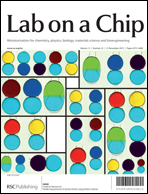A microfluidic device designed to induce media flow throughout pancreatic islets while limiting shear-induced damage†
Abstract
Pancreatic islets are heavily vascularized in vivo with fenestrated endothelial cells (ECs) to facilitate blood glucose-sensing and endocrine hormone secretion. The close proximity of insulin secreting beta cells and ECs also plays a critical role in modulating the proliferation and survival of both cell types with the mechanisms governing this interaction poorly understood. Isolated islets lose EC morphology and mass over a period of days in culture prohibiting study of this interaction in vitro. The loss of ECs also limits the efficacy of islet transplant revascularization in the treatment of Type 1 diabetes. We previously showed that microfluidically driven flow positively affects beta-cell function and EC survival in culture due to enhanced transport of media into the tissue. However, holding islets stationary in media flow using a dam-wall design also resulted in reduced glucose-stimulated metabolic and Ca2+ responses at the periphery of the tissue consistent with shear-induced damage. We have now created a device that traps islets into sequential cup-shaped nozzles. This hydrodynamic trap design limits flow velocity around the perimeter of the islet while enhancing media flow through the tissue. We demonstrate the feasibility of this device to dynamically treat and collect effluent from islets. We further show that treating islets in this device enhances EC morphology without reducing glucose-stimulate Ca2+ responses. These data reveal a microfluidic device to study EC and endocrine cell interaction that can be further leveraged to prime islets prior to transplantation.


 Please wait while we load your content...
Please wait while we load your content...